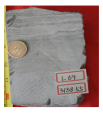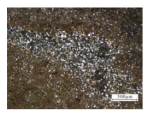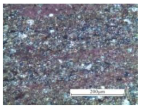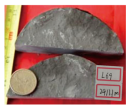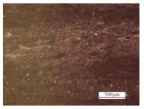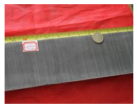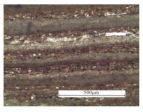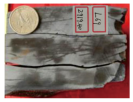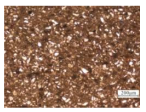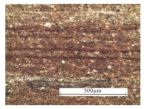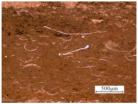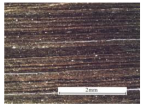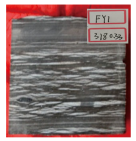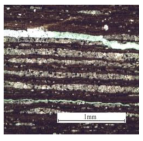Abstract
Based on core observation, rock thin sections, logging data, and testing data, taking the shale of the upper submember of the 4th Member to the lower submember of the 3rd Member of Paleogene Shahejie Formation in Jiyang Depression of Bohai Bay Basin as an example, we determine the lithofacies division scheme, divide the main lithofacies types, analyze the sedimentary origin and development location of different shale lithofacies, establish the continental lake basin sedimentary model, determine the types and enrichment areas of favorable lithofacies, and provide guidance for the exploration and development of Shale oil. The results show that: (1) According to the mineral composition, sedimentary structure, and organic matter abundance, the division scheme of shale lithofacies in the study area is proposed, and the shale lithofacies of the study area was mainly divided into 17 types. (2) Based on the lithologic changes, the lacustrine sedimentary shale area was divided into muddy water area, transition area, and clear water area. (3) Under the background of locally uplifted slope paleogeomorphology, considering the combined effects of climate, topography, hydrodynamic, mechanical, and chemical differentiation of sediments and biological habits, the sedimentary model of shale was established. (4) Organic-rich shale was mainly deposited between the clear water area and the end of the muddy water area, with the characteristics of water, brackish water, strong reduction, and water stratification, and was mainly enriched in the low-lying parts of paleotopography.
1. Introduction
With the large-scale and commercialization of shale oil and gas production in the United States, shale as the main reservoir of shale oil and gas has gradually received attention [1,2,3]. Compared with conventional oil and gas resources, shale oil and gas have the characteristics of continuous distribution, self-generation, self-storage, and large reserves. The continental lacustrine basin is widely developed in China, and the large-scale distribution of continental mudstone shale has significant resource potential, which lays a solid material foundation for the formation of large-scale shale oil and gas fields [4,5,6]. In recent years, through thin section identification, SEM, TOC analysis, pore permeability analysis, and other testing methods, domestic and foreign scholars have carried out systematic research on the reservoir space, pore evolution, and resource potential of shale [7,8,9,10,11], and provided important technical support for the exploration and development of shale oil and gas. However, there is a lack of systematic study on sedimentary genesis, sedimentary distribution, and sedimentary models of different shale facies of continental mudstone, and it is impossible to predict effectively the distribution of organic mudstone, which greatly restricts the exploration of shale oil and gas.
The division of shale facies is the basis of shale oil exploration and development. Currently, the lithofacies classification of continental shale mainly adopts the three terminal division schemes, and the division is carried out in combination with the TOC data [12,13,14,15]. On this basis, some scholars also regard sedimentary structures as the standard of shale lithofacies classification [16,17,18,19,20,21], making the lithofacies classification more representative. However, there are various division schemes for the three terminal elements, and no unified standard has been formed. Some division schemes are too complex and there are too many types of lithofacies.
Because shale is mostly continuous thick layer sedimentation and lithology is similar [22,23,24] with the lack of practical facies marks, previous research on shale sedimentation environments mostly adopts the element geochemical method [25,26,27]. However, due to the number of samples and their heterogeneity, the results of elemental geochemistry are frequently contradictory. In addition, the lithofacies of the terrestrial lacustrine basin are various and the lateral variation is fast, which further indicates that the sedimentary environment of the terrestrial lacustrine basin is complex and has micro-environmental zoning characteristics on the plane [28,29,30]. Establishing sedimentary models of shale facies can intuitively reflect the sedimentary characteristics and lithofacies combinations. However, currently, research on shale sedimentary patterns both domestically and internationally is mainly focused on marine shale [31,32,33,34], with limited research on lacustrine shale.
In this paper, the shale from the upper member of Paleogene Sha 4 to lower member of Sha 3 in Jiyang Depression of Bohai Bay Basin is selected as the research object. The lithofacies of the shale are subdivided and analyzed by using core, thin sections, and analytical data. The standard adopted for shale facies division is mostly “Sedimentary structures + rock composition + TOC content”, and the comparison of the characteristics of different shale facies is closely related to these three. Therefore, this paper comprehensively analyzes the sedimentary structure of shale and the sedimentary origin and sedimentary environment of rock composition, obtains the characteristics of sedimentary zoning formed by rivers flowing into lakes, and establishes a shale sedimentary model through thin section data, core data, and test data combined with previous research results, and analyzes favorable lithofacies sedimentary genesis and sedimentary environments.
2. Basic Geological Situation of the Study Area
Jiyang Depression belongs to the first-order structural unit of Bohai Bay Basin. It is located in the west of the Tanlu fault belt, the south of Chengning uplift, and the north of west Luxi uplift. Its east–west length is 240 km. The widest part is about 130 km, and the distribution area is 26,000 km2. The Jiyang Depression contains four negative secondary structural units in Dongying Depression, Huimin Depression, Zhanhua Depression, and Chezhen Depression, as well as a series of positive secondary structural units such as Gudao Uplift, Yihezhuang Uplift, Chenjiazhuang Uplift, Wudi Uplift, Binxian Uplift, and Kendong Qingtuozi Uplift, with typical uplift-concave structure (Figure 1a).
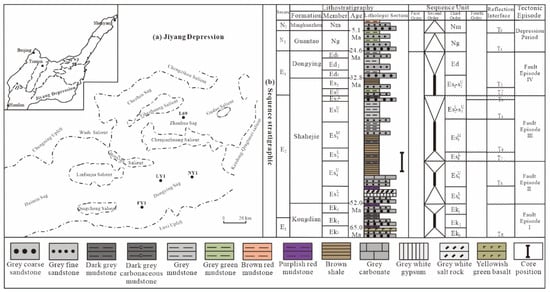
Figure 1.
Basic geological survey of Jiyang Depression.
The Paleogene Shahejie Formation is the main source rock horizon of Jiyang Depression, which is formed in the fault depression structural cycle, in which the upper member of Sha 4 and the lower member of Sha 3 are respectively located in the lacustrine intrusion system tract and lacustrine highstand system tract of the second order sequence, and all belong to the complete third order sequence (Figure 1b). Due to the continuous subsidence of the basin and the continuous injection of terrigenous clastic debris, a very thick lacustrine mudstone stratum developed in the upper submember-lower submember of Sha 4, in which the lithologic association of the upper submember-lower submember of Sha 4 is characterized by the development of thin interbeds of mudstone, marl (cloud) rock, and oil mud (shale) rock, and the development of beach bar sand or biological beach at the bottom.
3. Shale Facies Type and Characteristics
Lithofacies division is the basis of shale reservoir evaluation. Different shale lithofacies have different reservoir forming conditions and resources [35,36]. At present, the classification scheme of shale lithofacies is three-grade naming principle [37,38], in which carbonate minerals, felsic minerals, and clay minerals are set at three end elements. Lithology, sedimentary structure, and abundance of organic matter are the main factors affecting oil-bearing property, physical property, and shale oil mobility of shale [39]. In the process of shale lithofacies classification from upper member of Sha 4 to lower member of Sha 3 in Jiyang Depression, macroscopic structure and rock type are combined, and the lithofacies classification method of “four components and three end elements” of organic matter content is considered at the same time. Among them, the four components are ash (cloud) mineral, clay mineral, silty (feldspar) mineral, and organic matter, through the whole rock mineral analysis and organic carbon analysis test, and through volume fraction conversion [16,17,18], the three end elements are gray (cloud), clay, and silty (feldspar).
First, according to the statistic result that the volume fraction of organic matter in domestic oil shale is higher than 15.0% [40], the shale in upper part of Sha 4/lower part of Sha 3 in Jiyang Depression is divided into two types: rich organic matter shale and poor organic matter shale. For organic shale, if the organic matter is mainly of saprophytic type, it is called oil shale; if it is mainly of humic type, it is called carbon shale. For the shale with poor organic matter, according to the thickness of monolayer determined by the observation of the core and thin section of the study area, the shale with more than 50 cm is clumped, the 10~50 cm is clumped, the interlaminar interval is 1~10 cm, the interlaminar interval is 1 mm~1 cm, and the interlaminar interval is 1 mm [41]. On this basis, the lithofacies types of the shale in the study area are finely divided by the lime (cloud), clay, and silty (felsic) contents 25%, 50%, and 75%. respectively. According to the statistics of shale lithofacies types in Jiyang Depression, the main lithofacies types include 17 types, and their characteristics are shown in Table 1.

Table 1.
Main shale lithofacies types and characteristics of upper Es4 lower Es3 in Jiyang Depression.
4. Sedimentary Genesis of Shale
Direct analysis of the sedimentary mechanism of shale facies requires some special analysis and testing. In this article, due to the classification scheme of “sedimentary structure + rock components + TOC content” for shale facies, it is possible to analyze the sedimentary mechanism of shale microstructure, rock components, and organic matter content separately. Finally, the sedimentary mechanisms of the three are comprehensively considered to determine the sedimentary mechanisms of different shale facies.
4.1. Microstructural Sedimentary Genesis
Under the control of the sedimentary environment, the thickness of shale monolayer in the study area varies considerably, ranging from micron to meter. The rock components in massive and layered structures are uniformly distributed, and the micro-bedding type is massive (Table 2), which indicates that the sedimentation rate of muddy shale is relatively high during the sedimentation period, and it is mostly formed in the shallow water environment. The rock components in laminated and page-shaped structures are continuously or intermittently laminated and repeated, and the micro-bedding type is page-shaped (Table 2), which reflects the frequent periodic changes in sedimentary environment during the period of shale sedimentation, mechanical sedimentation, biological sedimentation, and (biological) chemical sedimentation alternating. The sedimentation rate is low, but the sedimentation time is long, which mostly reflects the sedimentary environment of deeper water. The sedimentary environment and variation in the thin layered structure are between the above two types, and the microscopic bedding type is mainly oriented distribution (Table 2), reflecting the shallow water environment. In addition, the interface of macro-structure in shale is mainly abrupt, which indicates that the rock composition is sensitive to the change in environment and is the response of rapid change in sedimentary environment. Therefore, in the same lithofacies, with the increase in water depth, the thickness of monolayer decreases, and the macroscopic structure has the trend of block, layer, thin layer, laminated layer, and page.

Table 2.
Micro-bedding style of shale.
The most typical macroscopic structure of lacustrine shale is in the form of page, and there are three types of laminae: (1) clastic laminae composed of silty sand and clay minerals; (2) organic rich textured layer; (3) and carbonate-rich laminates consisting of carbonate minerals. The laminae in the page-like structure are of various types, including one type, two types, three types, and four types (Figure 2a~d), of which the three types are the most common, i.e., the clastic laminae-rich organic laminae-rich carbonate laminae, and the four types are the most complete, i.e., the clastic laminae-rich organic laminae-rich carbonate laminae, in which the carbonate laminae can be further subdivided into the lower bright crystal carbonate laminae and the upper muddy crystal carbonate laminae. The combination of three types, two types, and one type can be regarded as the missing style of the combination of four types.
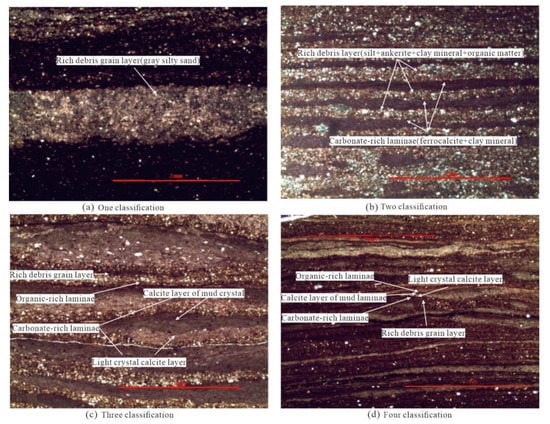
Figure 2.
Types of shale lamina combination in upper Es4-lower Es3 of Jiyang Depression.
In this paper, the formation of quartic laminae is analyzed. The terrestrial clasts, organic matter, and carbonate minerals in the laminae are of mechanical, biological, and (biological) chemical origin, respectively. Based on the features of “cold and dry winter and spring, hot and rainy summer and autumn, stratified lake water in winter and summer” in temperate zone or middle and south subtropical monsoon climate, the development model of four types laminated layer combination of shale was established. In spring, due to the increase in temperature and precipitation, the lake level rises, vertical exchange and mixing take place in the stratified water body, and the freshwater, debris, and inorganic salt supplied by the material source are conducive to the growth of algae such as diatom and ditch whipped algae [42], especially in the late spring and early summer, the algae flourish, die, and deposit, forming rich organic laminae. In summer, the climate temperature is high. The precipitation is sufficient and the organisms are flourishing. The carbonate-rich laminae are formed by the (biological) chemical and biological sedimentation. At the same time, the organic matter is difficult to precipitate and decomposes in a large amount due to the stratification of the water body, so the organic matter is relatively undeveloped. In autumn, the temperature began to decrease, the precipitation decreased, the salinity increased, and the stratified water began to mix again, which was beneficial to the growth of algae such as pelagic algae and the increase in organic matter and clay minerals. Because of the frequent change in sedimentary environment, the four-type laminated assemblage of page-like structure does not necessarily develop completely. The type of laminated assemblage, laminated monolayer thickness, and continuity of the laminated structure vary with the type of sedimentary environment, duration, and mixing degree of different parts, so as to evolve into laminated, thin, and laminated and massive.
4.2. Sedimentary Genesis of Rock Components
4.2.1. Sedimentation Mechanism of Rock Components
Silty sand (felsic minerals), clay minerals, and carbonate minerals in shale have different genetic mechanisms. To silty shale, the grain size of silty shale belongs to the micron scale, and its gravity is greater than the viscous resistance of the water body. Therefore, silty shale can be directly settled by traction flow or gravity flow medium, and is typically enriched in laminated layer or dense dispersion. Finer felsic minerals (very fine silty sand-clay grade), due to their small particle size, large specific surface area, and strong adsorption, result in the ability to adsorb clay minerals or organic matter together subsidence, but their total content in lacustrine shale less, usually less than 10%. Therefore, the deposition mechanism of silt is mainly mechanical sedimentation (Figure 3a).
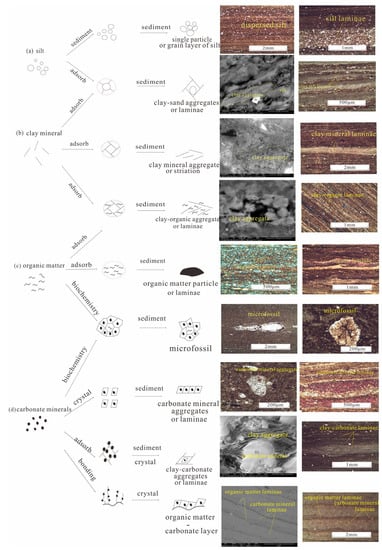
Figure 3.
Sedimentary mechanism of shale rock components.
Clay minerals have small particle size, rough surface, large specific surface area, can adsorb anions in the medium, and cause particles to repel each other; therefore, clay minerals can exist stably in the form of colloids in water and be transported a long distance by surface or laminar flow. However, when there is external ion implantation in the water medium, the electric field on the clay mineral surface can be changed to attract and condense into larger particles and overcome the buoyancy and viscous resistance to achieve colloidal settlement; therefore, clay minerals are mainly deposited by colloidal flocculation (Figure 3b).
Organic matter is common in shale, but its genesis is varied. Living microorganisms can form algae mat after growth, bloom, and death, and retain them to train laminae. Larger organisms, such as fish, bivalves, and gastropods, can settle directly after death. Organic matter is mainly dissolved and granular in water. Because of fine particles and irregular morphology, the adsorption of organic matter on clay minerals or silty sand causes the coagulation or adsorption of organic matter on the surface of sediment. Because the growth of planktonic microorganisms and the sedimentation of clay minerals tend to be weak in hydrodynamic environment, organic matter and clay minerals have similar surface physicochemical properties, and they are usually complexed together by deposit [43]. Therefore, the sedimentation of organic matter is the product of a combination of biological or biochemical, chemical, and mechanical sedimentation (Figure 3c).
There are various types of carbonate minerals in shale and their genetic mechanisms include chemical and biochemical (Figure 3d). When the climate is dry, the water body is concentrated, and the carbonate saturation is reached, microcrystalline calcite crystals are precipitated from the water body and precipitated on the surface of sediment or adsorbed to the surface of debris particles. Microorganisms can not only saturate and precipitate carbonates by biochemical processes but also trap and bond microcrystalline calcites to form laminae. At the same time, the skeleton of calcareous microorganisms is itself a carbonate component, and even enriches and integrates the laminae, such as algae. The occasional rounded, better carbonate gravel or mud gravel in shale is presumably formed by carbonate source supply, gravity flow channel erosion, or storm action.
4.2.2. The Indicative Significance of Sedimentary Environment of Rock Components
Rocks are not only the aggregates of minerals, but also the products of sedimentary environments. Modern sedimentation shows that when rivers flow into large lakes or oceans, not only mechanical debris and colloids, but also large amounts of freshwater and ions are injected, forming three different depositional zones on the plane: muddy water zone, transition zone, and clear water zone. Muddy water area refers to the range of water body affected by terrestrial debris in the edge of the lake basin for a long time. The salinity of water body is desalinated as freshwater–brackish water due to river water injection. The water body in this area is shallow, mostly above the wave base, with strong hydrodynamic force, and the sedimentary environment is a weak oxidation reduction environment. The clean water area refers to the range of the water body in the center of the lake basin, which is basically not affected by terrestrial debris. The water body has large salinity and is a brackish–saltwater environment. Meanwhile, the water body in the area is deeper, mostly below the storm wave base, with weak hydrodynamic force and clear water body. Due to the deep and quiet water body, the water body is often characterized by strong stratification and strong reducing environment. The sediments are primarily chemical and biological deposits [44]. Transition zone refers to the scope of the water body transitional between the muddy water area and the clean water area on the slope of the lake basin. The impact of the material source in this area is smaller than that in the muddy water area, and the water body is turbulent. As it is located in the platform, the water body develops upward of the current, and the water body environment is mainly composed of brackish water, medium stratification and reducing environment, and mechanical sedimentation, chemical sedimentation, and biological sedimentation coexist or alternate.
Silty sand in shale mainly depends on its own gravity to overcome the viscous resistance of the water body and realize single-particle mechanical sedimentation. Fine silty sand, very fine silty sand transported by surface flow, laminar flow or wind, and even feldspar minerals of clay grade, whose sedimentation mechanism is mostly in the form of single-particle mechanical sedimentation, are mainly deposited in the clean water area with weak hydrodynamic force. Therefore, silt units in shale not only indicate the source supply strength and hydrodynamic strength but also reflect the distance from the shoreline or water depth changes (Figure 4).
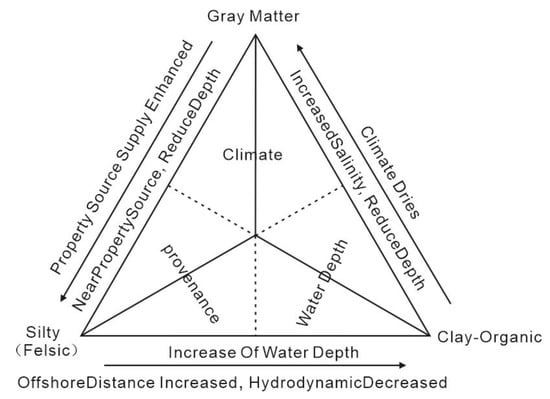
Figure 4.
Indicative significance of sedimentary environment of shale rock components.
Most of the clay minerals in shale are brought in by rivers, and a few are self-sedimentation or autogenesis. Clay minerals are developed in all regions of the lake basin, but tend to be deposited in the water environment. Climate conditions can also affect clay mineral content; wet climate helps chemical weathering, provides more clay minerals and other fine debris, and lake water depth is conducive to clay deposition. In addition, there is more fresh water supply under humid climate conditions causing lake water desalination, while under arid climate conditions, the lake shrinks, causing lake water salinization. Because the growth environment of plankton in the basin, the preservation environment after death and the climatic conditions are close to the sedimentary environment of clay minerals, the clay minerals and organic matter in the lacustrine shale closely coexist, and they are usually considered as clay-organic matter units. Therefore, the clay mineral-organic unit in shale can reflect the hydrodynamic strength, climate type, and salinity, and the water depth is a good indicator of the hydrodynamic strength, while the water depth change can reflect the salinity change (Figure 4).
The carbonate minerals in shale are mainly mudstone calcite and dolomite, most of which are formed in the syngenetic or quasi-syngenetic period, mainly by chemical sedimentation or biochemical sedimentation. Because the carbonate sedimentation needs clear, shallow, warm, dynamic, and brackish water medium conditions, it is mainly deposited in the transition area and clear water area, especially in the transition area where the paleotopography is relatively high and enriched in carbonate. At the same time, the change in salinity of lake water caused by the climate can also affect the carbonate deposit. The climate drought causes the evaporation and concentration of the water and the salinity increase, which are favorable for the carbonate deposit, while the climate humidity causes the fresh water supply and the salinity decrease, which is unfavorable for the carbonate deposit. Therefore, ash (cloud) unit in shale is an advantageous indicator of water salinity and can reflect climate change (Figure 4).
Silty-grey (cloudy), silty-clayey, organic matter and clay, and organic matter-grey (cloudy) are composed of silty sand, clay minerals, and lime (cloudy) minerals. The silty-grey (cloud) sequence mainly represents the mixing degree of mechanical sedimentation and (biological) chemical sedimentation, reflecting the strength of the source supply: The higher the silty sand content, the closer the sedimentation area to the source area, the higher the proportion of mechanical sedimentation. The silty-clay-organic matter sequence mainly represents the degree of mechanical differentiation or the degree of mixing of mechanical sedimentation with colloidal sedimentation and biological sedimentation, which reflects the strength of hydrodynamics and can indicate the change in water depth or offshore distance: The higher the content of clay minerals and organic matter, the more thorough the mechanical differentiation and the deeper the water body. Clay, organic matter-ash (cloud) sequence, mainly represents the mixing degree of colloidal sedimentation or biological sedimentation and (biological) chemical sedimentation, reflects the salinity of the water body, and can indicate climate change and water depth change: The higher the content of ash (cloud), the higher the proportion of (biological) chemical sedimentation, the shallower the water body, the greater the salinity, and the more arid the climate (Figure 4).
The contents of silty sand and clay minerals in shale facies of the lower member of Sha 3 and upper member of Sha 4 in Jiyang Depression are approximately equal, which not only indicates the limited range of lake basin during sedimentation and insufficient mechanical sedimentation differentiation but also indicates that clay minerals in terrestrial shale coagulate into silty sand fraction (about 10 μm) and settle together with silty sand particles. In addition, silt and clay minerals can be used as a unit to indicate mechanical sedimentation because they are mainly supplied from land sources and cannot be recognized as “argillaceous” by naked eyes during core observation. On this basis, the three-unit diagrams represented by silty (feldspar), clay-organic matter, and ash (cloud) are transformed into three units of argillaceous (silty sand and clay)-ash (cloud)-organic matter, indicating the mixing degree of mechanical sedimentation, (biological) chemical sedimentation, and biological sedimentation, respectively (Figure 5), so as to judge the genesis of mudstone.
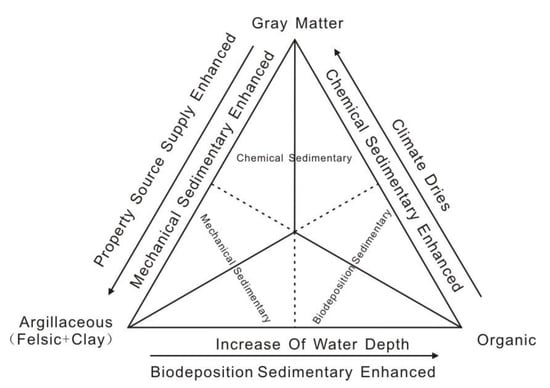
Figure 5.
Sedimentary significance of shale rock components.
5. Shale Lithofacies Sedimentary Model
Based on the classification of lithofacies, combined with the sedimentary environment and background of various lithofacies, a comprehensive analysis is conducted to establish a sedimentary model with comprehensive properties that can characterize the characteristics and distribution of various lithofacies and their combinations.
The complete sedimentary model should include structural background, source supply, lithofacies type and distribution, water body conditions, and biological development. The paleogeomorphology in the sedimentary period from the upper member of Sha 4 to the lower member of Sha 3 in Jiyang Depression is a large slope with interspersed concave and uplift, belonging to the offshore continental lacustrine basin. According to the characteristics of lithofacies division and the main controlling factors of sedimentation, the sedimentary types of upper and lower Sha 4 submember of Jiyang Depression are divided into two types: muddy water desalination sedimentation and clean water salinization sedimentation. The second largest group includes the clean water brackish sediments in the transition area and the water brackish sediments in the clean water area, which represents the clear and salinity characteristics of the water body (Table 3).

Table 3.
Sedimentary zoning and characteristics of upper Member of Sha 4-Lower Member of Sha 3 in Jiyang Depression.
Lacustrine sedimentation zoning is the result of mechanical differentiation, chemical differentiation, and biological distribution of sediments. From the edge of the lake in the center of the lake, the particle size of the debris decreases according to the law of gravel-sand-silt-clay, while the chemical differentiation and sedimentation increase gradually when the mechanical sedimentation decreases (Figure 6). Chemical sedimentation is mainly controlled by mineral solubility, from lake edge to lake center. With the increase in mineral solubility, the sedimentation is differentiated in the order of oxide-phosphate-silicate-carbonate-sulfate and halide. The distribution of plankton in the continental lake basin can be influenced by many factors, such as hydrodynamics, light, temperature, salinity, PH, oxygen content, and inorganic salts, etc. The fine silty sand in shale is mainly formed by mechanical sedimentation, the size of clay minerals is in the range of colloid, and agglomeration occurs, while the evaporation minerals such as carbonate and gypsum are mainly formed by chemical sedimentation. Therefore, the living conditions of plankton in the lake are highly consistent with the depositional conditions of clay minerals and carbonates (clean, shallow, warm, and brackish water), resulting in organic matter, clay minerals, and carbonate minerals often coexisting in different laminates in the same lithofacies, but organic matter and clay minerals are closely complexed and positively correlated, while they are adjacent to carbonate minerals and negatively correlated. This not only indicates the relationship between mechanical deposition and chemical deposition, but also indicates that the growth of plankton requires certain salinity, which is roughly equivalent to the solubility of carbonate.
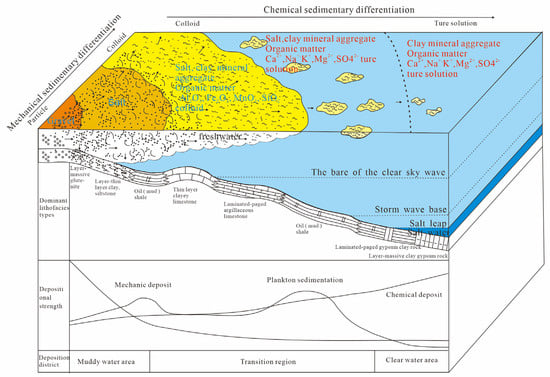
Figure 6.
Model diagram of mud shale sedimentation in upper member of Sha 4—lower member of Sha 3 in Jiyang Depression.
Through the analysis of the sedimentary elements of shale, the shale lithology from the lake basin edge to the lake basin center shows regular zoning and change in plane: The lake basin edge is the sandstone, siltstone, and clay rocks rich in oxygen in the river-delta system, the lake basin slope is the lithology such as oxygen-poor grey silty clay rocks, limestone, oolitic limestone, and biological limestone, and the lake basin center is the anaerobic black rich organic shale with gypsum rocks developed locally. The existence of local protuberances or break belts in paleotopography is closely related to the lithofacies development in the transition area, which form a local high-energy microenvironment, suitable for wave-resisting organism propagation, conducive to the development of reef, beach bar, and biological limestone, while the local protuberances or break belts are usually a low-energy environment, suitable for plankton growth, conducive to the development of oil mud (shale). Organic muddy shale is mainly deposited in the end of muddy water area–clean water area far away from coarse clastic minerals, and enriched in low-lying parts of paleotopography, such as deep depression of basin, local sub-depression of slope of basin and low-energy parts before and after local protrusion or slope break. Three main types of organic mudstone are formed, which are semi-deep lake–deep lake facies oil mudstone (shale), lagoon or lake bay facies oil shale, and prodelta facies oil mudstone.
6. Conclusions
- (1)
- Based on the sedimentary structure, mineral component, and organic matter, the lithofacies division scheme of the “four-component and three-end-element” shale is proposed. The shale in the upper part of Sha 4–lower part of Sha 3 in Jiyang Depression is divided into 17 main lithofacies types, such as oil-mud (shale) and shale-lime (cloud) clay.
- (2)
- Through research on the microstructure and composition of shale rocks, the results indicate that the muddy shale in the upper submember of Sha 4–lower submember of Sha 3 has sedimentary zoning characteristics, including muddy water desalination deposit in muddy water area, clean water brackish deposit in the transition area, and water brackish deposit in clean water area.
- (3)
- Considering the combined effects of climate, topography, fluid mechanics, mechanical and chemical differentiation of sediments, and biological habits, a sedimentary model of shale is established, which indicates each lithofacies type’s sedimentary climate, redox conditions, sedimentary location, and so on. For example, the muddy shale is rich in organic matter and formed in the transition period of dry-hot climate and humid climate or humid climate, deposited in the water medium conditions of static water, brackish water, strong reduction, and stratification of water body, distributed in the end in the clean water area of the muddy water area far away from coarse clastic materials, and enriched in the low-lying part of paleotopography. This is of great significance for finding favorable lithofacies and guiding the exploration and development of shale oil.
Author Contributions
Conceptualization, C.M. and Q.Z.; methodology, C.M. and S.L.; software, C.M. and X.G.; validation, C.M., Q.Z. and Y.F.; formal analysis, C.M.; investigation, S.L.; resources, C.M.; data curation, X.L. and Y.Q.; writing—original draft preparation, C.M.; writing—review and editing, S.L.; visualization, C.M.; supervision, Q.Z.; project administration, Y.F.; funding acquisition, Q.Z. All authors have read and agreed to the published version of the manuscript.
Funding
This work was funded by Natural Science Foundation of China (Grant Nos. 42172153, 41802172, 41830431) and Fundamental Research Funds for the Central Universities of China (Grant No. 20CX02109A). The authors thank Professor Qiang Jin of China University of Petroleum (East China) for his constructive suggestions on the design of the thermal simulation experiments.
Data Availability Statement
The data presented in this study are available on request from the corresponding author. The data are not publicly available because some of the data involves trade secrets of oilfield companies and cannot be widely disclosed.
Conflicts of Interest
The authors declare no conflict of interest.
References
- Ghadeer, S.G.; Macquaker, J.H. Sediment transport processes in an ancient mud-dominated succession: A comparison of processes operating in marine offshore settings and anoxic basinal environments. J. Geol. Soc. Lond. 2011, 168, 1121–1132. [Google Scholar] [CrossRef]
- Plint, A.G. Mud dispersal across a Cretaceous prodelta: Stormgenerated, wave-enhanced sediment gravity flows inferred from mudstone micro-texture and microfacies. Sedimentology 2014, 61, 609–647. [Google Scholar] [CrossRef]
- Zou, C.N.; Zhu, R.K.; Wu, S.T.; Yang, Z.; Tao, S.Z.; Yuan, X.J.; Hou, L.H.; Yang, H.; Xu, C.C.; Li, D.H.; et al. Types, characteristics, genesis and prospects of conventional and unconventional hydrocarbon accumulations: Taking tight oil and tight gas in China as an instance. Acta. Petrol. Sin. 2012, 33, 173–187. [Google Scholar]
- Zou, C.N.; Zhang, G.Y.; Tao, S.Z.; Su, Y.H.; Li, X.D.; Li, J.Z.; Dong, D.Z.; Zhu, R.K.; Yuan, X.J.; Hou, L.H.; et al. Geological features, major discoveries and unconventional petroleum geology in the global petroleum exploration. Pet. Explor. Dev. 2010, 37, 129–145. [Google Scholar]
- Huang, J.L.; Zou, C.N.; Li, J.Z.; Dong, D.Z.; Wang, S.; Wang, S.Q.; Cheng, K.M. Shale gas generation and potential of the lower Cambrian Qiongzhushi formation in Southern Sichuan basin, China. Pet. Explor. Dev. 2012, 39, 69–75. [Google Scholar] [CrossRef]
- Wu, S.T.; Zou, C.N.; Zhu, R.K.; Yuan, X.J.; Yao, J.L.; Yang, Z.; Sun, L.; Bai, B. Reservoir quality characterization of Upper Triassic Chang 7 shale in Ordos basin. Earth Sci. 2015, 40, 1810–1823. [Google Scholar]
- Li, J.; Yu, B.S.; Xia, X.H.; Tian, Y.K.; Li, Y.L.; Zhou, H.; Ma, Y.S. The characteristics of the upper Permian shale reservoir in the northwest of Guizhou province, China. Earth Sci. 2015, 22, 301–311. [Google Scholar]
- Luo, X.P.; Wu, P.; Zhao, J.H.; Yang, N. Study advances on organic pores in organic matter-rich mud shale. J. Chengdu Univ. Technol. 2015, 42, 50–57. [Google Scholar]
- Yang, C.; Zhang, J.C.; Li, W.J.; Jing, T.Y.; Sun, R.; Wang, Z.P.; He, W.; Lu, Y.Y. Microscopic pore characteristics of Sha-3 and Sha-4 shale and their accumulation significance in Liaohe Depression. Oil Gas Geol. 2014, 35, 286–294. [Google Scholar]
- Zeng, X.; Cai, J.G.; Dong, Z.; Wang, X.J.; Hao, Y.Q. Sedimentary characteristics and hydrocarbon generation potential of mudstone and shale: A case study of Middle submember of member 3 and upper submember of member 4 in Shahejie formation in Dongying sag. Acta. Petrol. Sin. 2017, 38, 31–41. [Google Scholar]
- Niu, L.; Zhu, R.K.; Wang, L.S.; Bai, B.; Wang, T.; Cui, J.G. Characteristics and evolution of the Meso-Neoproterozoic shale gas reservoir in the northern North China. Acta. Petrol. Sin. 2015, 36, 664–672. [Google Scholar]
- Er, C.; Luo, A.X.; Zhao, J.Z.; Zhang, Z.Y.; Bai, Y.B.; Cheng, D.X.; Wu, S.T.; Wei, Z.K.; Zhang, J. Lithofacies features of organic-rich shale of the Triassic Yanchang Formation in Huachi area, Ordos Basin. Earth Sci. Front. 2016, 23, 108–117. [Google Scholar]
- Cao, X.N.; Jiang, Z.X.; Zhu, D.Y.; Qiu, H.Y.; Chen, L.; Luo, D.D.; Shuang, Z.J.; Li, W.B. Lithofacies types and reservoir characteristics of continental shales of Ziliujing Formation in northeastern Sichuan Basin. Nat. Gas Geosci. 2019, 30, 1782–1793. [Google Scholar]
- Wang, L.; Zeng, W.T.; Xia, X.M.; Zhou, H.Y.; Hua, H.; Shang, P.; Zhou, X.X. Study on lithofacies types and sedimentary environment of black shale of Qingshankou Formation in Qijia-Gulong Depression, Songliao Basin. Nat. Gas Geosci. 2019, 30, 1125–1133. [Google Scholar]
- Kang, J.H.; Wang, X.Z.; Xie, S.Y.; Zeng, M.D.; Du, Y.; Zhang, R.; Zhang, S.M.; Li, Y. Lithofacies types and reservoir characteristics of shales of Jurassic Daanzhai member in central Sichuan Basin. Lithol. Reserv. 2022, 34, 53–65. [Google Scholar]
- Dong, C.M.; Lin, C.Y.; Sun, X.; Yuan, M.Y. A method of classification of shale set. J. China Univ. Pet. 2015, 39, 1–6. [Google Scholar]
- Liu, H.M.; Wang, Y.; Yang, Y.H.; Zhang, S. Sedimentary Environment and Lithofacies of Fine—Grained Hybrid Sedimentary in Dongying Sag: A Case of Fine—Grained Sedimentary System of the Es4. Earth Sci. 2020, 45, 3543–3555. [Google Scholar]
- Hu, Z.Q.; Wang, R.Y.; Liu, Z.B.; Feng, D.J.; Yang, Z.H.; Wang, P.W. Source-reservoir characteristics and coupling evaluations for the Lower Jurassic lacustrine shale gas reservoir in the Sichuan Basin. Earth Sci. Front. 2021, 28, 261–272. [Google Scholar]
- Sun, B. Evaluation of Geological Sweet Spot of Shale Oil: A Case Study of the Second Member of Funing Formation in Haian Sag, Subei Basin. Available online: https://kns.cnki.net/kcms/detail/detail.aspx?doi=10.27643/d.cnki.gsybu.2021.001369&dbcode=CMFD (accessed on 29 May 2023).
- Zeng, B.; Liu, X.P.; Liu, G.Y.; Wang, S.C.; Li, G.Y. Logging identification and prediction of lithofacies of lacustrine shale system in Shichang Sub-Sag, Nanpu Depression. Bull. Geol. Sci. Technol. 2021, 40, 69–79. [Google Scholar]
- Liu, H.M.; Zhang, S.; Wang, X.J.; Zhang, P.F.; Li, J.L.; Wang, Y.; Wei, X.L.; Yin, Y.; Zhu, D.Y. Types and Characteristics of Shale Lithofacies Combinations in Continental Faulted Basins: A Case Study from Upper Sub-Member of Es4 in Dongying Sag, Jiyang Depression. Earth Sci. 2023, 48, 30–48. [Google Scholar]
- Jin, Z.M.; Tan, X.C.; Tang, H.; Shen, A.J.; Qiao, Z.F.; Zheng, J.F.; Li, F.; Zhang, S.X.; Chen, L.; Zhou, C.G. Sedimentary environment and petrological features of organic-rich fine sediments in shallow water overlapping deposits: A case study of Cambrian Yuertus Formation in northwestern Tarim Basin, NW China. Pet. Explor. Dev. 2020, 47, 476–489. [Google Scholar] [CrossRef]
- Kohl, D.; Slingerland, R.; Arthur, M.; Bracht, R.; Engelder, T. Sequence stratigraphy and depositional environments of the Shamokin(Union Springs) Member, Marcellus Formation, and associated strata in the Middle Appalachian Basin. AAPG Bull. 2014, 98, 483–513. [Google Scholar] [CrossRef]
- Smith, L.B.; Schieber, J.; Wilson, R.D. Shallow-water onlap model for the deposition of Devonian black shales in New York, USA. Geology 2019, 47, 279–283. [Google Scholar] [CrossRef]
- Robert, G.; Stephen, C. Mississippian Barnett Shale: Lithofacies and depositional setting of a deep water shale-gas succession in the Fort Worth Basin, Texas. AAPG Bull. 2007, 91, 579–601. [Google Scholar]
- Deng, H.W.; Qian, K. Sedimentary Geochemistry and Environmental Analysis; Gansu Science and Technology Press: Lanzhou, China, 1993. [Google Scholar]
- Qian, L.J.; Chen, H.D.; Li, L.B.; Xu, S.L.; Ou, L.H. Geochemical characteristics and environmental implications of middle Jurassic Shaximiao formation, western margin of Sichuan basin. Acta Sedimentol. Sin. 2012, 30, 1061–1071. [Google Scholar]
- Zhang, S.; Chen, S.Y.; Tan, M.Y.; Zhang, Y.Y.; Sun, B.B.; Gong, W.L.; Hu, Z.Y.; Hou, Z.S. Characterization of sedimentary microfacies of shale in the lower third sub-member of Shahejie formation, western Dongying Sag. Acta Petrol. Sin. 2014, 35, 633–643. [Google Scholar]
- Zou, C.N.; Dong, D.Z.; Wang, Y.M.; Li, X.J.; Huang, J.L.; Wang, S.F.; Guan, Q.Z.; Zhang, C.C.; Wang, H.Y.; Liu, H.L.; et al. Shale gas in China: Characteristics, challenges and prospects(I). Pet. Explor. Dev. 2015, 42, 689–701. [Google Scholar] [CrossRef]
- Liu, B.; Lv, Y.F.; Meng, Y.L.; Li, X.N.; Guo, X.B.; Ma, Q.; Zhao, W.C. Petrologic characteristics and genetic model of lacustrine lamellar fine-grained rock and its significance for shale oil exploration: A case study of Permian Lucaogou formation in Malang sag, Santanghu Basin, NW China. Pet. Explor. Dev. 2015, 42, 598–607. [Google Scholar] [CrossRef]
- Xu, Z.Y.; Jiang, S.; Xiong, S.Y.; Liang, X.; Wang, G.C.; Guo, Y.L.; He, Y.; Rao, D.Q. Characteristics and Depositional Model of the Lower Paleozoic Organic Rich Shale in the Yangtze Continental Block. Acta Sedimentol. Sin. 2015, 33, 21–35. [Google Scholar]
- Wu, Y.; Fan, T.L.; Ding, H.Y. Lithofacies and Sedimentary Model of the Lower Combrian Marine Shale in the Upper Yangtze Platform. Geoscience 2017, 31, 1222–1232. [Google Scholar]
- Liang, X.C.; Niu, X.; Hu, M.Y.; Li, Y.; Hu, Z.G.; Cai, Q.S. Development characteristics and sedimentary environment of black shale of Lower Cambrian Niutitang Formation in western Hunan and Hubei. Lithol. Reserv. 2023, 35, 102–114. [Google Scholar]
- Chen, L.; Tan, X.C.; Zheng, J.; Chen, X.; Yang, Y.; Xiong, M.; Wang, G.X.; Ji, Y.B. Shallow-water onlap sedimentary mode of black organic-rich shale in the Longmaxi Formation, Upper Yangtze area. J. Palaeogeogr. 2023, 25, 614–627. [Google Scholar]
- Yang, W.Q.; Jiang, Y.L.; Wang, Y. Study on shale facies sedimentary environment of lower Es3-upper Es4 in Dongying sag. J. China Univ. Pet. 2015, 39, 19–26. [Google Scholar]
- Yang, Z.H.; Li, Z.M.; Wang, G.S.; Teng, G.E.; Shen, B.J. Enlightenment from petrology character, depositional environment and depositional model of typical shale gas reservoirs in North America. Geol. Sci. Technol. Inf. 2010, 29, 59–65. [Google Scholar]
- Spears, D.A. Towards a classification of shales. J. Geol. Soc. London 1980, 137, 125–129. [Google Scholar] [CrossRef]
- James, J.; BO, H. Lithofacies summary of the Mississippian Barnett Shale, Mitchell 2 T.P. Sims well, Wise County, Texas. AAPG Bull. 2007, 91, 437–443. [Google Scholar]
- Wang, Y.; Wang, X.J.; Song, G.Q.; Liu, H.M.; Zhu, D.S.; Zhu, D.Y.; Ding, J.H.; Yang, W.Q.; Yin, Y.; Zhang, S.; et al. Genetic connection between mud shale lithofacies and shale oil enrichment in Jiyang Depression, Bohai Bay Basin. Pet. Explor. Dev. 2016, 43, 696–704. [Google Scholar] [CrossRef]
- Zeng, S.Q.; Wang, J.; Fu, X.G.; Feng, X.L.; Chen, W.B.; Sun, W. Characteristic and formation condition of the Cretaceous marine oil shale in the Qiangtang Basin. Geol. Rev. 2014, 60, 449–463. [Google Scholar]
- Zhao, C.L.; Zhu, X.M. Sedimentary Petrology, 3rd ed.; Petroleum Industry Press: Beijing, China, 2000. [Google Scholar]
- Liu, C.L.; Xu, J.L.; Wang, P.X. Algal blooms: The primary mechanism in the formation of lacustrine petroleum source rocks. Geol. Rev. 2014, 60, 449–463. [Google Scholar]
- Bennett, R.H.; Bryant, W.R.; Hulbert, M.H.; Chiou, W.A.; Faas, R.W.; Kasprowicz, J.; Li, H.; Lomenick, T.; O’Brien, N.R.; Pamukcu, S.; et al. Microstructure of Fine-Grained Sediments from Mud to Shale; Springer: Berlin/Heidelberg, Germany, 1991. [Google Scholar]
- Cai, J.G. Organic Clay Complexes in Argillaceous Sediments and Mudstones; Science Press: Beijing, China, 2004. [Google Scholar]
Disclaimer/Publisher’s Note: The statements, opinions and data contained in all publications are solely those of the individual author(s) and contributor(s) and not of MDPI and/or the editor(s). MDPI and/or the editor(s) disclaim responsibility for any injury to people or property resulting from any ideas, methods, instructions or products referred to in the content. |
© 2023 by the authors. Licensee MDPI, Basel, Switzerland. This article is an open access article distributed under the terms and conditions of the Creative Commons Attribution (CC BY) license (https://creativecommons.org/licenses/by/4.0/).
